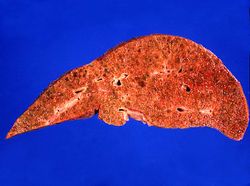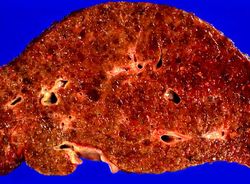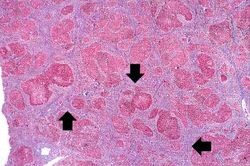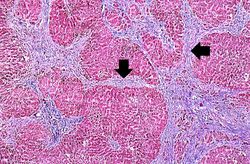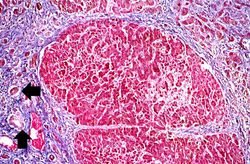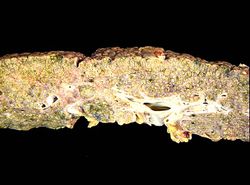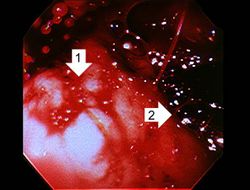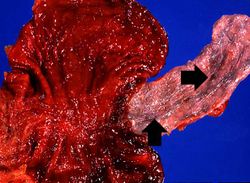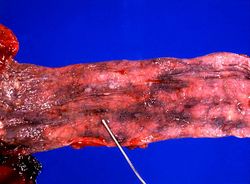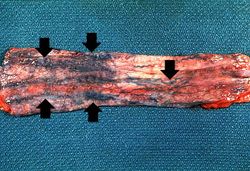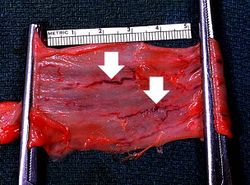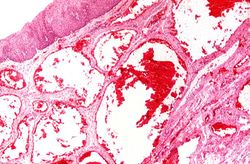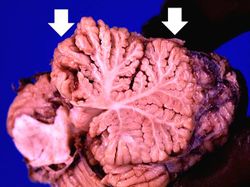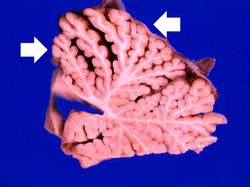IPLab:Lab 12:Alcoholic Cirrhosis
Contents
Clinical Summary[edit]
This 56-year-old white male came to the emergency room because of weakness, lack of appetite, shortness of breath, abdominal distention, and an altered mental status. He was a known alcoholic who drank approximately one pint of whiskey per day. Physical examination revealed a wasted appearance, icterus, a protuberant abdomen, bilateral gynecomastia, sparse axillary hair, and spider angiomata on his chest. Liver and spleen were not palpable, the testes were atrophic, and the legs showed petechial hemorrhages and 3+ edema. Admission laboratory values revealed a hemoglobin of 9.5 g/dL, an MCV of 106 fL, a platelet count of 97,000/mL, and a prothrombin time of 19.2 seconds. In addition, his albumin was 2.3 g/dL, bilirubin, total 6.5 mg/dL, AST 21.0 U/L, ALT 56 U/L, alkaline phosphatase 180 U/L, and GGT 320 U/L. The patient was treated with thiamine, folate, multivitamins, and vitamin K and an intravenous line was placed to infuse 5% dextrose. An esophagogastroduodenoscopy (EGD) was performed which demonstrated large esophageal varices with evidence of previous bleeding sites. Two days after admission the patient developed a massive hematemesis and his hematocrit dropped to 17%. Emergency EGD showed ruptured esophageal varices. Despite successful sclerotherapy and supportive transfusions, the patient lapsed into coma and died the next day.
Images[edit]
In this is medium-power photomicrograph of trichrome stained liver the bands of fibrous tissue are seen to form "bridges" between triad areas (arrows); this is called "bridging fibrosis." Also note the fibrous tissue (arrows) and how the hepatocytes are separated into nodules by this fibrous tissue.
In this high-power photomicrograph of trichrome-stained liver, the bands of fibrous tissue surround the hepatocyte nodules. There is some degeneration and dropout of hepatocytes in this nodule. Also note the increased numbers of bile ducts in the triad area (arrows). Bile duct proliferation is a common feature in many hepatitides.
This photograph taken from still another patient at autopsy demonstrates the esophageal varices in the distal esophagus (arrows). The esophagus was clamped before removing the esophagus from the body in order to trap the blood in these distended varices. It is obvious how easily these thin-walled superficial varices could rupture and bleed.
Study Questions[edit]
Additional Resources[edit]
Reference[edit]
- eMedicine Medical Library: Cirrhosis
- eMedicine Medical Library: Cirrhosis Imaging
- Merck Manual: Alcoholic Liver Disease
Journal Articles[edit]
- Fujimoto J. Gene therapy for liver cirrhosis. J Gastroenterol Hepatol 2000 Mar;15 Suppl:D33-6.
- Ge PS and Runyon BA Treatment of Patients with Cirrhosis. NEJM 2016 Aug 25 375(8):767.
Images[edit]
Related IPLab Cases[edit]
| |||||
Shortness of breath is a common clinical manifestation of heart failure.
Hyperbilirubinemia making the patient appear yellow. Also called jaundice.
Jaundice (or icterus) is a state of hyperbilirubinemia (increased bilirubin in the blood) in which bile pigment is deposited in the skin, mucous membranes, and scleras. This deposition of bile pigment results in a yellow appearance.
A focal network of small arteries and arterioles arranged in a radial pattern with a central red spot.
Normal hemoglobin for a male is 14 to 17.2 gm/dL.
The normal mean corpuscular volume (MCV) is 83 to 99 fL.
A normal prothrombin time is 12.6 to 14.6 seconds.
The normal albumin level 3.9 to 4.8 gram/dL.
A normal total bilirubin level is 0 to 1.0 mg/dL.
A normal aspartate aminotransferase (AST) for a male is <37 U/L.
A normal alanine aminotransferase (ALT) is 7 to 56 U/L.
A normal alkaline phosphatase is 39 to 117 U/L.
A normal gamma-glutamyl transpeptidase (GGT) is 0 to 65 U/L.
Hematemesis is the vomiting of blood.
A normal hematocrit for a male is 39 to 49%.
Nodular hyperplasia of the prostate--characterized by large discrete prostatic nodules--is a common disorder in men over 50 years of age. The nodules cause the prostate to be enlarged and to have an increased weight. The human prostate is surrounded by a restrictive capsule. These nodules cause increased pressure within the capsule which leads to constriction of the urethra as it passes through the prostate. Urethral constriction leads to retention of urine.
Cirrhosis is a liver disease characterized by necrosis, fibrosis, loss of normal liver architecture, and hyperplastic nodules.
